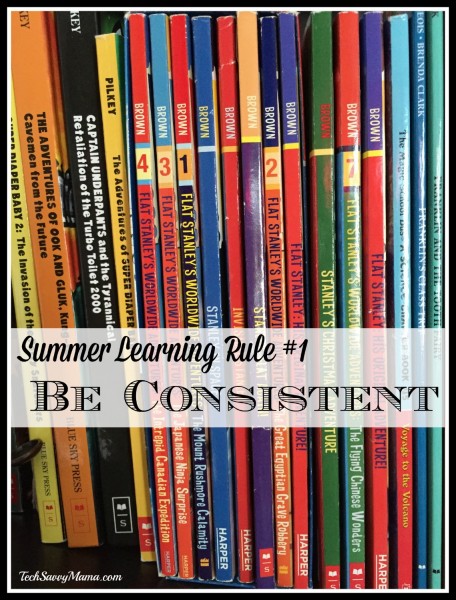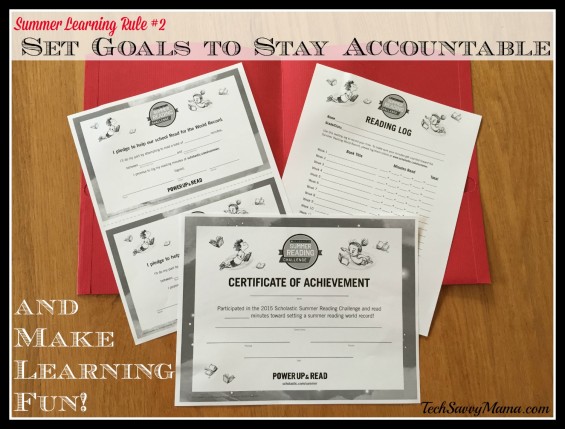
This is a sponsored post
Every year when the school year ends, my kids dive head first into summer with a trip to visit their grandparents out on their farm. Their blissful week consisted of hands-on learning in an idyllic place where was canoeing, cooking projects, crafts, gardening, time with animals (my in- laws have 9 sheep, 2 Labradors, and 3 cats), plus cooperation and creative problem solving due to kid-powered tasks that they saw as a fun challenge. But all good things must come to an end and today begins a week that is more typical of what our summer will be like until school begins.
As I balance work, kid activities, and the need to do a little bit of learning each day, I’ve developed three rules to help us complete the lengthy summer packets while also maintaining motivation for the next nine weeks until school begins again. My goals are to be consistent, find ways to hold my kids accountable and make learning fun, while finding other ways to maintain their interests throughout the summer. Here’s a look at how I plan to do this and the resources I’m using, including many from the Scholastic Summer Reading Challenge “Power Up & Read,” Powered by Energizer®.

1. Be Consistent
With a 36 page math packet and three different lengthy reading activities just for my soon-to-be fourth grader, I know consistency is key. Each day we’re going to tackle a little math and reading during the morning and afternoon. Since children thrive off of routines, having a consistent routine for completing summer work can be reassuring but ours is flexible to make it achievable without frustration.
My goal is to tackle a little summer learning in the morning and afternoon each day. This provides us with structure but also flexibility due to inconsistent weeks where there are some weeks with camp and others without. What remains the same is the expectation of doing a math and reading each day. Every day my son will get to choose if he wants to start his day with math or reading but whatever isn’t done first thing, becomes his afternoon activity. This provides an element of choice but also ensures he does both each day at times that work well with our summer schedules.

2. Set Goals to Stay Accountable and Make Learning Fun
Setting goals are concrete ways to make kids accountable but they also serve as something to work towards to celebrate when they’re achieved. The summer work that school sent home has a built in goal- to finish it by the time school starts for recognition at the start of the year but what about reading for pleasure?
The more kids read, the better readers they become. Reading for enjoyment is important and while some of the reading that he will be doing is tied to school goals, there’s also an element of choice that ensure that he’s reading books that are of high interest that he will enjoy.
Since goals present a fun challenge, work with your child to set an age-appropriate goal that’s just right for them. They could pledge to read for a certain number of minutes, want to read a certain number of fiction or nonfiction books during the summer, or simply set a goal to read for a set number of minutes each day. Our school reading specialist recommends that children in grades K-2 read for 15 minutes a day while older kids read for 30-60 minutes daily.
Goals become even more fun when there are fun ways to track progress. Scholastic has a number of different resources available through the Summer Reading Challenge that are designed to make goal setting fun. Not only will your child be helping to set a new world record in reading (sign up here) but these free printable resources from Scholastic can be used in your home to help your kids set goals to make reading more fun:
- Pledge form to read for a certain number of minutes— By filling this out, your child commits to reading a certain number of minutes during the summer. Work together to figure out a fair number for your child based on their age. Pledge form in Español.
- Reading Log— This helpful resource provides a space to record book titles plus the number of minutes read each week. For kids who like to chart their progress and love grand totals, this is a way to list books read during each week of the summer plus minutes read during each week. At the end of the summer, kids can add up the total number of minutes read and look back on all the wonderful titles they read. Kids can keep track of the number of minutes read using a kitchen timer but we personally love the Reading log in Español.
- Certificate of Achievement— Since every child likes to feel a sense of success, the Certificate of Achievement is a great way to celebrate accomplishments at the end of the summer. Download the certificate in Español.
3. Diversify Experiences to Maintain Motivation
Variety is the spice of life and doing different activities that involve reading can help maintain interest throughout the summer. Here are some ideas that can diversify
Need some new books to read?
Visit the library to discover new titles or hold a book swap with some friends during a playdate. A book swap for members of a swim or dive team is also a fun way to motivate everyone on the team to keep reading poolside during their downtime!
Read something different.
- Love graphic novels? Try a comic book. We love Calvin and Hobbes in our house!
- Loving the series you’re reading but can’t take all the books to follow on vacation? Download them on an eReader!
- Love nonfiction? Try reading a kid-friendly magazine like American Girl, Sports Illustrated Kids, or National Geographic Kids.
- Have a favorite character from a book? Look for them in an app! Scholastic has many apps featuring favorite characters such as Clifford, Mrs. Frizzle from the Magic School Bus, Word Girl, The 39 Clues, Geronimo Stilton, Captain Underpants, and more that extend reading beyond the pages of a book through an interactive platform that can maintain motivation when interest in books starts to wane. Browse among the Scholastic apps here.
Good readers are also good writers.
Since reading and writing skills go hand in hand, give your child an opportunity to share what they’re reading by writing about it. These free downloadable templates from Scholastic make writing about books read an enjoyable summer task
- The Innovation Machine Printable
- Innovation Story Starter Printable
- Graphic organizer to record thoughts on books read
- Make a scrapbook to reflect on favorite characters
- Write your own book review
For more information about keeping your kids reading this summer:
- Sign up for the Scholastic Summer Reading Challenge
- Find more Scholastic Resources to keep your kids reading all summer long!
- Learn more about the Energizer® Instant Win Game
- Follow @Scholastic on Twitter
- Like the Energizer® Bunny on Facebook
- Follow the #SummerReading hashtag to see how other bloggers are using Scholastic Summer Reading Challenge resources with their families!

And parents aren’t the only ones invested in keeping our kids reading this summer! Just last week Scholastic announced a new with U.S. Governors and their spouses supporting the Summer Reading Challenge! Forty-four U.S. Governors’ Spouses, along with the Governors of Colorado, Vermont and the U.S. territories Northern Mariana Islands and U.S. Virgin Islands have signed on as “Reading Ambassadors” for the 2015 Scholastic Summer Reading Challenge and are helping to spread the important message that children must keep reading throughout the summer months. To jumpstart excitement about summer reading, these Governors and Governors’ Spouses will each deliver 500 new books donated by Scholastic to schools in their states. To see if your state governor and their spouse is in support of the Scholastic #SummerReading Challenge, visit this for the full list.

Images courtesy of Scholastic. I am a member of the Scholastic Circle and receive books and other products from Scholastic for my involvement. All opinions are my own.




